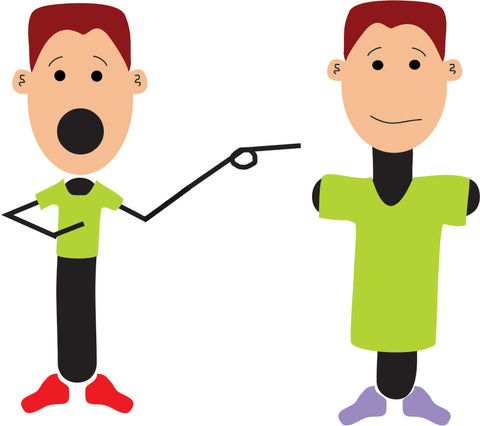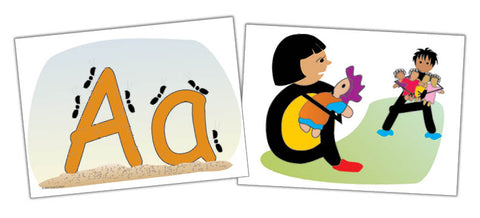Teaching Struggling Learners: Steps for Success
When I was in grad school, I could hardly contain my excitement when the time came for taking remedial reading courses. I just couldn’t wait to find the answers to questions that had plagued me about why seemingly bright children struggled to learn to read. Imagine my chagrin when I found that the class was preparing me to test, detect learning differences, track reading rates, classify text as to reading level, etc. It didn't seem that any of this would help me to successfully teach reading to a non-reader.
Over the years since, I have learned about a whole array of classifications for disabilities. There are so many! The impression one could get is that children are getting more and more broken, and we are developing more and more detailed labels for describing them. It appears that what is missing is more and more evolved solutions to accompany this highly classified collection of labels. Those solutions are what have always interested me!
Children and the System
-
If we continue to examine the child, we are pitting thousands of children against one educational system. There is one specific educational approach with minor variations here and there (still basically pretty recognizable), but there are thousands upon thousands of uniquely designed children out there.
Imagine taking your five children to shop for clothes. You choose the store that everyone goes to: Kid’s Clothes. The store is very organized and research-based to give you, the shopper, the best shopping experience. There is a long rack of boys’ shirts, another of boys’ pants, a long rack of girls’ dresses, etc. So you take your girls to their area and the boys to theirs. Within a few hours, all of you are distressed and upset. You have only one child that fits into the clothes! The other four children are all wrong for these clothes. The only thing they leave with is ill-fitting clothes and plenty of labels telling them how they are broken!

-
When we focus on the child and label them using a term that sounds absolute and professional, the child will become that even more! Imagine pouring concrete into a wooden form and watching it set. “As a man [or child] thinketh in his heart, so IS HE!”
One day that is branded on my memory was a day in which I was subbing for a fourth-grade teacher. I entered the room and was accosted by a very articulate boy, who announced assertively that he was ADHD and could not control himself. He spent the rest of the day proving it. He informed me every few moments what he couldn't help doing. He was living up so perfectly to what his diagnosis said he was.
- The more we focus on the imagined problem with the child, the less effective we will be as teachers. When I was a little girl trying to learn to ride a bike, there were two big things I wanted to NOT hit as I wobbled across the yard. One was our concrete block house, and the other one was a particularly thorny orange tree. The more I wanted to avoid hitting those obstacles, the more I looked at them, and guess what? The more unerringly my bike steered right into them!
If I am teaching a child and in my mind I am focused on their inability to memorize spelling words, my disbelief will be transmitted to them and my focus on the problem will become their focus on the problem as well.
- Every adult I have taken the time to talk with can describe what they are good at, what they enjoy doing, how they remember things, what tasks they are gifted at, etc. Some of us know well that we can’t hear verbal directions and recall them for more than a nano-second, so we look at and rely on maps to navigate. Other people can do really complex math problems in their heads. Why is it then, that we expect every single child should be able to memorize strings of letters (spelling), memorize math facts, or memorize and apply phonics rules, using the same method for all?
We are all wonderfully designed to perform exactly what we should in our lifetimes. And none of us should compare ourselves to another person. We generally understand this truth for adults, but the minute a child comes along, we try every way possible to get them to fit into a narrow educational mold.

The traditional educational system is designed for the left-brain dominant, sequential learner. Content is delivered verbally, and is taught in steps, children study, review, and attempt to memorize content to show on a test. This method tends to lead to struggles for about 40% of children. This leaves us with the question: How do we help struggling learners unlock their learning strengths?
Steps for Success
Simplify
The best way to teach children is to get to the point right away. Children do not need excess details and information that is above their learning level and interest. For instance, in teaching reading, the traditional steps include:
- learning all letter names & their sounds
- putting letters in alphabetical order
- sounding out
- memorizing blends
- etc.
Once children have mastered these steps, then reading books are introduced. This process works well for many children, but for others, they simply do not learn this way. Some children need to understand the "why" behind what they are being taught.

Some children become hopelessly lost in the process when they are asked to learn the letter names first, then learn the name of an object that represents each letter, then learn the sounds. They don't know how to manage all that information that, to them, seems unrelated and without purpose. If we simplify the process for them and let them understand that words are made of sounds and those sounds are represented by symbols called letters, they will have far less to manage. They can understand that A is the picture of the sound of "a." I have not yet met a child who did not pick up the letter names along the way, but I have met plenty of children who knew letter names but could not successfully decode words.
Here is an example of learning sounds and the "why":
1. Teach the sound of short A and the word "a."

2. Teach the sound of short T.

3. Teach the word "at."

By showing students that letters put together make words, it gives them an understanding for why they are learning letter names and sounds.
 Effective Focus
Effective Focus
Eliminate busy work and focus on effective lessons. You can tell which activities fall into the busy work category because the child is simply not enjoying it and is not engaged. Effective and engaging activities incorporate critical thinking skills such as figuring something out or inventing something. If your child is engaged, they are learning!
Try our Teaching the Water Cycle activity for an effective and engaging lesson.

Use Plenty of Images
Images are very beneficial for many children who struggle with memorization. Try this activity for yourself to see how helpful images can be. Have someone describe a picture to you. When they have finished, have them show you the picture. Which was more effective at getting across the reality of the object(s) in the picture: the verbal description or the photo? For many children, using visuals makes all the difference between struggling and success!

Include Body Motion
When I have trouble remembering a phone number (which is always), I know to “dial it” on a keypad. While I am doing that, I notice the shape of what I dialed and I also am storing up that visual pattern in the muscles of my body.

Every child who is good with some physical activity is going to benefit from physical movement to accompany learning. By movement, I don’t just mean bouncing; I mean a movement that reflects what they are learning. When counting by twos, for instance, have them march in a line but lean over heavily on each even number. Their bodies will remember the even numbers as they hear their mouths say the even numbers at the same time. Body motion activates the brain, which increases understanding and retention of information.
Real-Life Connections
Anytime you can transition a concept to something tangible, learning will be so much easier. When you can show your child how the material you are teaching relates to the real world, they are much more likely to make concrete connections and retain the information.

For example, when teaching about money, use real or toy money to "buy" things or bring them to the store and show them how you use money to buy things.

Another example is teaching measurement by having your child measure materials to build something. These are just two examples; there are so many more creative ways to relate "school work" to real-world experiences.
Look for Patterns
The brain is a pattern-seeking organ. Patterns provide order and help to make connections. There is beauty in patterns, and nature is full of them. Music is made of patterns; math is as well. I have seen a child come to life when they saw the patterns in learning. Unrelated details are hard to do anything with.
Rather than relying on memorization, use patterns to teach in a way that bypasses memorization and gives the child tools for deciphering unknowns.
For example, when doing math problems, teach groups of facts that have something in common (i.e. present problems that have the same sum).

When teaching phonics and spelling, group words together that share a sound spelling (i.e. high, light, might, right).

Through practice, children will come to remember the pattern visually, like having a mental snapshot stored in their minds.
Keep the Time in Mind
Aim to keep lessons short and engaging. Our brains can only take in so much new information at one time. After too much time, we tend to tune out anything new, leading to ineffective teaching. Research has shown that taking breaks and moving your body may help your brain learn new skills as well as increase productivity, energy, and focus. When your child begins to wiggle or they become restless, check the activity or lesson you are doing for interest level. If you can inject some mystery or novelty into it, by all means, do it. However, it is important to stop before your child loses interest or becomes frustrated. Learning should be a positive experience.
End the Cycle
If the method you have been using isn't working, consider trying something new. Take some time to study your child and ask some questions. This will help you to understand what helps and what doesn't help them learn.

Conclusion
What a child needs is not more drills, but an intentionally different approach. We should abandon the notion that the child is broken and cannot learn; rather success is much more likely if we adjust the way we teach.
Please know we are here for you. We have a lot of information, how-to guides, teaching tips, lessons, examples, and resources in our blogs.
Contact us today!





Leave a comment